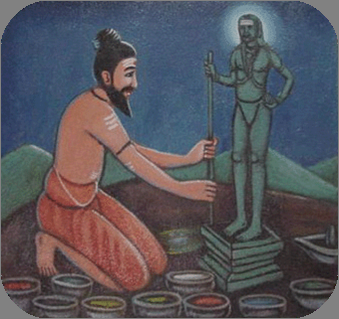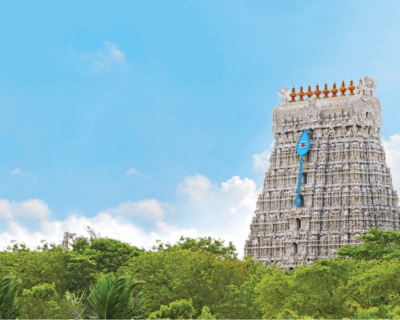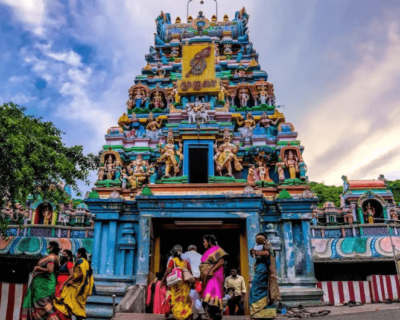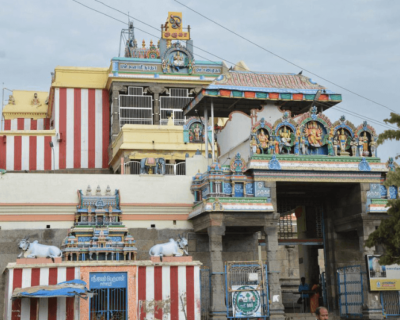Palani Murugan Temple
Structure of the Temple: The temple of Lord Muruga is situated on top of the Palani Hillock. By the side of this another Hillock, namely Idumban Malai is situated. Within a short distance of 4km, the greenish beautiful western ghats is located, forming a charming and lush green background for the Palani Temple.
The Palani Murugan Temple (officially Dhandayuthapani Swamy Temple) is a revered hill shrine in Palani, its third abodes of the six sacred abodes (Arupadaiveedu) of Lord Murugan and Palani was called Pothini.
The Shanmukha River flows 2 km west of Palani and is considered holy. This river is formed by the joining of six rivers: Palaru, Varatharu, Bhatularu, Suruliyaru, Kallaru, and Pachaiyaru
Palani Murugan Temple History
There is no clear record of how this temple was first built. However, Tamil scriptures say that the idol of Lord Murugan was placed by Sage Bogar, who created it thousands of years ago. The exact time is not known. He made the idol using a mix of nine poisonous substances which, when combined in the right amounts, became a powerful, everlasting medicine. Over time, due to thefts and neglect, the idol was damaged.
Later, a king from the Chola dynasty, known as a Perumal, ordered the construction of the temple between the 2nd and 5th centuries AD. The temple has stood strong for centuries, surviving attacks and the passage of time, even as the Chera, Chola, and Pandya empires disappeared.
An Unbreakable Architecture
At the center of the temple is a shrine believed to have been built during the Chera period. Surrounding it is a walkway that still shows signs of Pandya architecture, including carvings of two fish — the Pandya symbol. Tamil writings are carved into the walls of the sanctum (the inner holy space).
On top of the sanctum is a large golden tower called a Gopuram, which is common in South Indian temples. It is decorated with many statues of Lord Kartikeya and other gods and goddesses who serve him.
The Scientific Side
For centuries, temple idols have been carved from granite, a strong stone made of all five natural elements—earth, water, fire, air, and ether.
Sage Bogar, with the help of 17 other Siddhars (enlightened beings), created Murugan’s idol using a secret formula called “Nava Paashaanam”—a powerful mixture of nine poisonous metals and over 4,498 rare herbs. This blend became solid like granite but had healing and medicinal powers.
It’s believed that around 4,900 years ago, during the beginning of the current age (Kaliyuga), the idol was placed at the top of the sacred mountain where it has been worshipped ever since. Sadly, the idol is now weak and could break. About 100 years ago, a Siddha who was a temple trustee scraped the idol’s back and sold medicine made from it.
Modern scientists and mineral experts have tried to study the idol’s material, but they couldn’t identify it. Even advanced tools like the Perkin-Elmer 707 spectrophotometer failed to detect its ingredients. It remains a mystery.
Mythological History
The Wise Fruit and the Two Brothers
Long ago, Sage Narada brought a magical Fruit of Knowledge to Lord Shiva. This fruit had all the wisdom in the world inside it. Lord Shiva wanted to give it to his sons, Murugan and Ganesha. But Narada said, “This fruit is special. It should not be cut in half.”
So, Lord Shiva gave them a challenge. He said, “Whoever goes around the world three times first will get the fruit.”
Murugan, brave and fast, jumped on his peacock and flew off to circle the earth.
Ganesha stood still and thought for a moment. Then he slowly walked around his parents, Lord Shiva and Goddess Parvati, three times. When he finished, he said, “To me, you are the whole world.”
Shiva and Parvati smiled with joy. They were touched by his love and gave him the Fruit of Knowledge.
When Murugan came back and saw what happened, he was sad. He didn’t argue or ask for the fruit. Instead, he felt a strong need to grow wiser on his own. So, he went to the hills of Palani, left behind his royal life, and began to meditate.
From that day on, he became known as Dhandayuthapani, the god with a staff, who lives in peace and silence on the hill, guiding those who seek true wisdom. Angered and disillusioned, Murugan renounced his family and took refuge at Palani Hills (then called Tiru Avinankudi), declaring “I am the Fruit” (“Pazham Nee” in Tamil), which eventually became Palani.
Thala Virutcham : Kadambam Tree Thala
Theertham : Shanmuga Nadhi
Aagamam : Saiva Agamas Kumara Thanthiram
Description of the Songs
- Thirupugazh
- Palani Thiruvayiram
- Palanipathigam, Palani Nanmanimaalai, Thirupalani venpa, Palani venpa anthathi, Palanapuri maalai, Palani Koil Vinnappam
- Palani Pillaitamil
- Kumara visaiyagirivela chinnavovaiyan
- Mayil vidu thoodhu
- Palani thalapuranam Sages and
Divine Poets related with Palani :
- Arunagirinadhar
- Vannasarabam Dhandapani Swamigal
- Mambala Kavisinga Navalar
- Jamin Visaiyagirivela chinnavovaiyan
- Vaiyapuri pallu
- Ku.Nadesa Gounder
- Balasubramaniya Kavirayar
Temple Amenities
Access to Palani Hill Temple
-
Stone Steps
-
693 steps to the hilltop.
-
Traditional path, usually taken barefoot by devotees.
-
-
Winch Service
-
Rope-pulled trolley system.
-
Operates every 15–20 minutes.
-
Separate queues for free and paid tickets.
-
-
Rope Car (Cable Car)
-
Operates from 7 AM to 9 PM.
-
Faster and scenic option to reach the temple.
-
Ticket cost: ₹15 (normal), ₹50 (special/priority).
-
Marriage Hall
The marriage halls at Palani are provided and maintained by the Arulmigu Dhandayuthapani Swamy Devasthanam, the official temple administration. These halls are conveniently located near the hill base, offering easy access for families and guests, and are situated close to the main temple complex, allowing couples to receive the blessings of Lord Murugan as part of their wedding rituals.
Available Marriage Halls
-
Thirukalyana Mandapam – Large hall (500+ people capacity).
-
Kalyana Mandapam 1, 2, 3 – Medium halls (~200–300 people).
-
Mini Mandapam on Hilltop – For small, simple ceremonies. ₹5,000 – ₹20,000 (based on hall and time slot)
Tonsure Facility
To facilitate the devotees visiting the Hill temple to pay their Hair Tonsure prayers, hair tonsuring sheds have been set up in the temple.
Facilities are located at several spots near the base of the hill:
-
Tiru Avinankudi Temple shed
-
Shanmuganathi Mudi Mandapam
-
Round Tana
-
Near Head Office
-
Karthikeyan Vidhuthi
-
Lower Winch Station
-
Near Patha Vinayakar Temple
-
Mudished (near Devar statue)
-
New spot near Patha Vinayagar Temple offered improved amenities
Parking Facility
-
Free Parking: There are designated areas near the temple where visitors can park their vehicles at no cost.
-
Paid Parking: For those seeking closer proximity or additional services, several private pay-and-park facilities are available in the vicinity.
Information Center
-
Located near temple steps and at Palani bus stand.
-
Offers details on darshan timings, poojas, winch/rope car schedules.
-
Guides devotees on ticket types, special darshan, and accommodation.
Palani Murugan Temple Poojai
| Pooja Name | Pooja Timings |
| Vilaa pooja (Sadhu Sanniyasi Alangaram) | 06:40 AM to 07:15 AM IST |
| Sirukala Shanthi Pooja (Vedar Alangaram) | 08:00 AM to 08:30 AM IST |
| Kalasandhi pooja (Balasubramaniyar Alangaram) | 09:00 AM to 09:30 AM IST |
| Uchikkala Pooja (Vaithekal Alangaram) | 12:00 PM to 12:45 PM IST |
| Sayaraksha Pooja (Evening) (Raja Alangaram) | 05:30 PM to 06:15 PM IST |
| Rakaala Pooja (Pushpa Alangaram) | 08:30 PM to 09:00 PM IST |
Palani Murugan Temple Archanai & Other Fees
| Fees Description | Fees |
| Vila Pooja | 150 |
| kala santhi Pooja kattalai | 900 |
| SiruKala Santhi Pooja | 150 |
| Siru Kalasanthi Pooja Kattalai | 900 |
| Villa Pooja Kattalai | 900 |
| Irakala Pooja | 150 |
| Irakala Pooja Kattalai | 900 |
| Sayaratchai Pooja Kattalai | 900 |
| Kala Santhi Pooja | 150 |
| Sayaratchai Pooja | 150 |
Palani Murugan Temple 2025 Festivals
| Festival | Date | Significance¬es |
|---|---|---|
| Thaipusam | 11 February 2025 (Thai Poosam) | 10-day celebration, Silver Car – Day 6, Golden Car – Day 7 |
| Panguni Uthiram | 10–11 April 2025 | Uttiram Nakshatra: 10 Apr 12:24 PM to 11 Apr 3:10 PMMurugan’s divine wedding |
| Vaikasi Visakam | May–June 2025 (Vaikasi month) | Full Moon day – Lord Murugan’s birthday; special abhishekam & poojas |
| Skanda Shashti / Surasamharam | Oct–Nov 2025 (Aippasi/Karthigai) | 6-day fasting, final day Surasamharam (Murugan’s victory over evil) |
| Vijayadashami | 2 October 2025 | Auspicious pujas: 2:09–2:57 PM (Vijay Muhurat), 1:21–3:45 PM (Aparahna) |
On Thaipusam ten days, Panguni Uttaram ten days, Kandhar Shashti ten days, monthly Karthigai, Maha Deepa Karthigai, Thai Pongal, Tamil and English New Year, all days of Margazhi month and day of Diwali, the shrine opens at 4.00 am and closes after 10.30 pm depending on the







